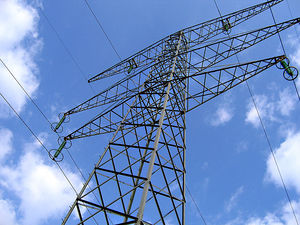LESSON 7: TRANSMISSION AND UTILISATION OF ELECTRICITY
Electrical transmission is the process of delivering generated electricity, usually over long distances, to the distribution grid located in populated areas. An important part of this process includes transformers which are used to increase voltage levels to make long distance transmission feasible.
The electrical transmission system combined with power plants, distribution systems, and sub-stations to form what is known as the electrical grid. The grid meets society's electricity needs, and is what gets the electrical power from its generation to its end use. Since power plants are most often located outside of densely populated areas, the transmission system must be fairly large.
Power Lines
Power lines or transmission lines, such as those in Figure 1, transport electricity from place to place. Usually, this electricity is alternating current so step-up transformers can increase the voltage. This increased voltage allows efficient transmission for 500 kilometers or less. There are 3 types of lines:
- Overhead lines are very high voltage, between 100 kV and 800 kV, and do the majority of long distance transmission. They must be high voltage in order to minimize power losses to resistance.
- Underground lines are used to transport power through populated areas, underwater, or pretty much anywhere that overhead lines can't be used. They are less common than overhead lines due to heat-related losses and higher cost.
- Subtransmission lines carry lower voltages (26 kV - 69 kV) to distribution stations, and can be overhead or underground.
The formulas for calculating power are:
2 X R
where
I is the current in amperes
R is the resistance in ohms

Comments
Post a Comment